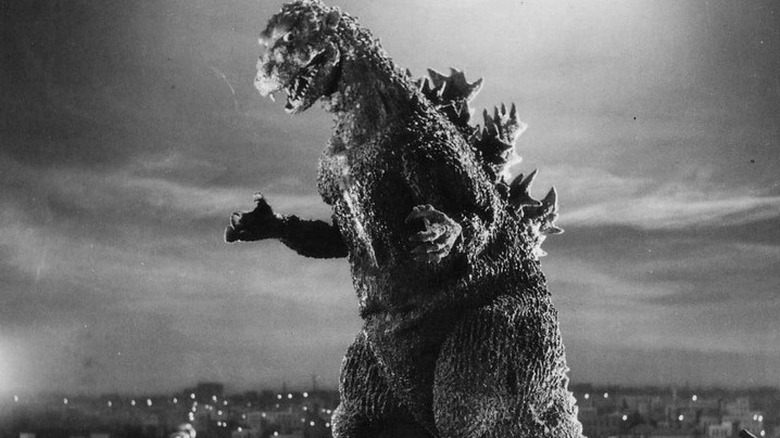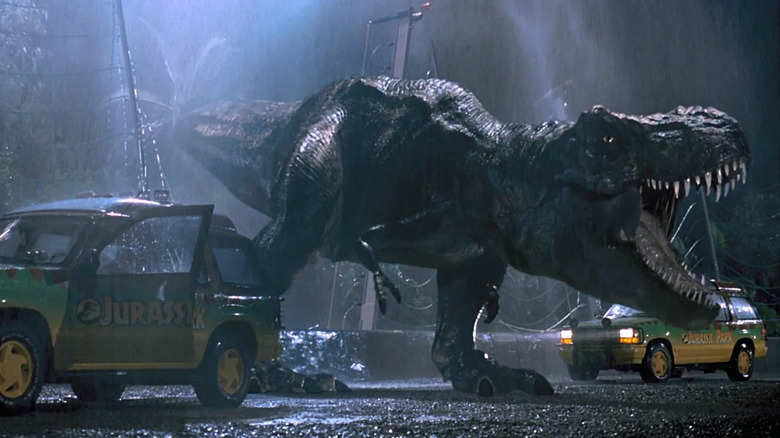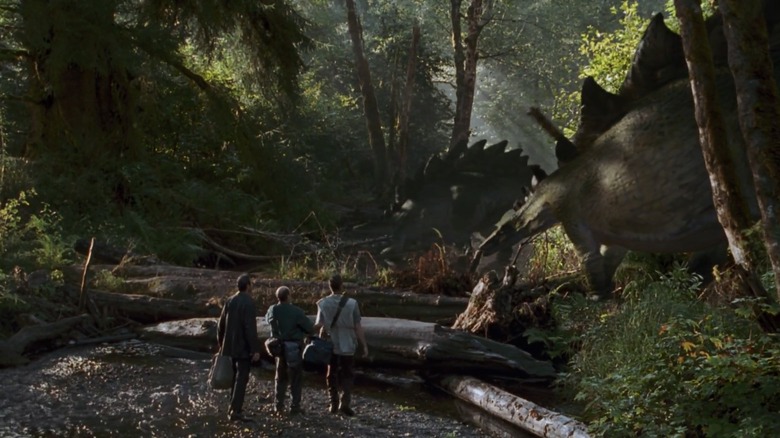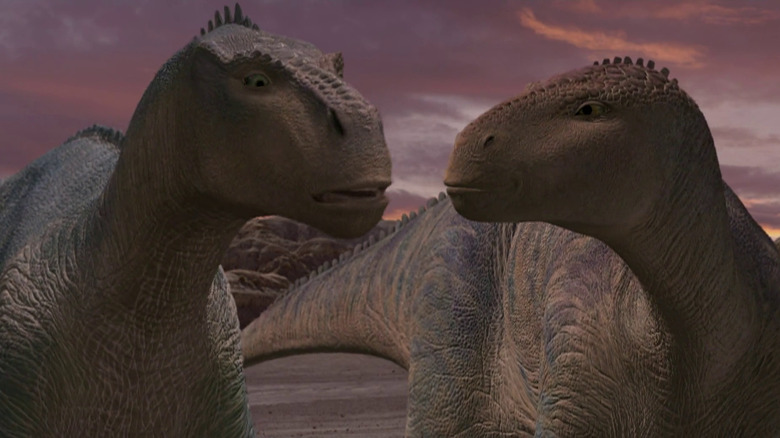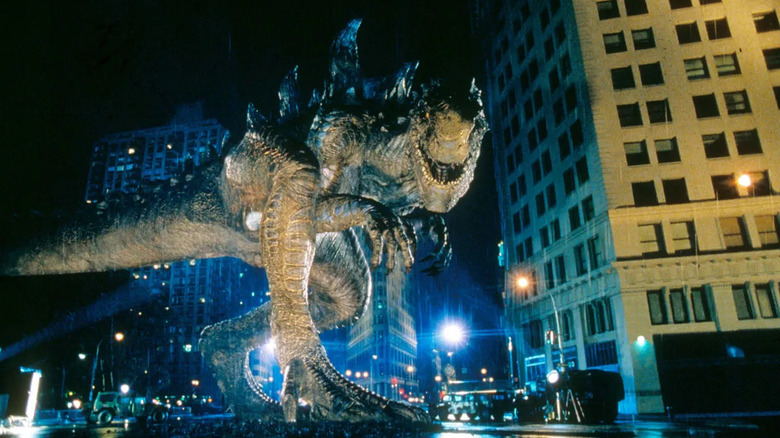The Real-Life Dinosaurs That Were Combined Into Godzilla's Iconic Design
Godzilla is a creature all his own, but he's often classified as a dinosaur; one dinosaur species, the Gojirasaurus, was even named in 1997 as a tribute to the King of the Monsters. It should go without saying, though, that Godzilla doesn't resemble any real fossils that paleontologists have found.
Godzilla was created in 1954, debuting in his first movie that year (directed by Ishirō Honda). There had been prior dinosaur movies, such as "The Lost World" and "King Kong" where the animals were brought to life with stop-motion, so audiences recognized the notion and imagery of a dinosaur. Still, scientific knowledge of these prehistoric beasts was more limited back then. "Godzilla" covers its bases by suggesting the creature was mutated via atomic radiation, but its star still looks little like any real dinosaur.
What makes one giant lizard-looking beast different from another? For starters, not even the largest of (discovered) dinosaurs even approach Godzilla's 300+ foot height. There's no way to test this theory, but I'm guessing no dinosaurs breathed colorful fire like Godzilla does either.
The recent American-produced MonsterVerse movies don't describe Godzilla and the other Titans as dinosaurs per se, but they are depicted as belonging to prehistoric, mostly extinct species that once ruled the Earth. However, these films still use a variation of the original Godzilla design; as explained in history book "Godzilla on My Mind: Fifty Years of the King of Monsters" by William Tsutsui, that design was based on three real dinosaur species.
Can you guess which?
Godzilla's design owes a lot to the T-Rex
The most famous of all the dinosaurs is also the most terrifying: Tyrannosaurus rex, or the King Tyrant Lizard. How fitting that the king of the dinosaurs inspired the King of the Monsters.
The T-Rex, the most famous of the predatory dinosaurs, dwelled in North America during the late Cretaceous era, the twilight of dinosaurs' time on Earth. It was a theropod, a class of carnivorous dinosaurs that walked on two hind legs with shorter arms at the front of their bodies. T-Rex, Allosaurus, Velociraptors, all of these were theropods, and Godzilla's body shape corresponds to theirs, particularly his snout and sharp teeth.
In 1954, it was believed that theropods walked upright, lifting their heads high and their tails dragging along the ground. You can see this not only in Godzilla's lumbering posture, but also contemporary depictions of the T-Rex. It's since been discovered that theropods were horizontally-shaped; their primary body mass was like a horizontal line, with the tail flowing through the air to balance their bodies as they walked.
However, Godzilla still walks like 1950s scientists expected a T-Rex to; since he's not really a dinosaur, there's no reason Godzilla's depictions have to adhere to the latest paleontology.
Godzilla has the plates of a Stegosaurus
Not all of the intimidating-looking dinosaurs were carnivores, and it wasn't only carnivorous dinosaurs that inspired Godzilla's look.
The second dinosaur species that the designers at Toho looked at was the Stegosaurus, or "roof lizard." This dinosaur was a herbivore that lived during the Jurassic era (200ish million years ago, when dinosaurs had well and truly taken over the Earth). However, the two rows of diamond-shaped ridges along its back and the spikes on the end of its tail indicate that it was well-defended against predators (think of how lions would much prefer to hunt a zebra or antelope rather than an armored rhinoceros.) Similar species existed, but Stegosaurus is the archetypal one (the taxonomic group is even known as "Stegosauria").
The Stegosaurus' most distinguishing feature is the one aped for Godzilla; its plates. Like the dinosaur, Godzilla has two rows of dorsal plates. The shape isn't an exact match (Godzilla's are spikier), but like on Stegosaurus, the plates grow larger until they reach the middle of Godzilla's back then start to shrink as they flow along his tail.
The Iguanodon was Godzilla's third dinosaur parent
The third dinosaur species thrown into the Godzilla stew is the most surprising one; the Iguanodon. (These days, you might recognize this species as the star of Disney's 2000 animated picture "Dinosaur").
Iguanodon was a herbivore that lived during the Cretaceous era in what is now western Europe. It was also the second dinosaur discovered (after the Megalosaurus); its remains were first discovered in 1820s England by the geologist Gideon Mantell. (The first Iguanodon fossils discovered were teeth, hence why its name means "Iguana Teeth").
Current depictions of Iguanodon could fit the bill of "generic dinosaur." The creature had a quadrupedal lizard shaped body with a long tail; it somewhat resembled a Hadrosaur, but lacked that group's distinctive duck-bills. Instead, Iguanodon had a distinctive spike on their thumbs.
Why was this creature chosen to help design Godzilla? Analysis of Iguanodon fossils suggest they could walk bipedally on their hind legs as well (perhaps, as some have suggested, standing upright to reach food on tall trees). It wouldn't be their preferred way of moving, but they could walk like Godzilla would millions of years later.
Godzilla 1998 amped up the dinosaur influence
Steven Spielberg saw "Godzilla" as a young man, specifically the American rerelease "Godzilla, King of the Monsters!" which featured scenes of actor Raymond Burr playing an English-speaking journalist spliced into the action. "Godzilla" no doubt played in Spielberg's mind as he made his own dinosaur attack movie, 1993's "Jurassic Park." The 1997 "Jurassic Park" sequel — "The Lost World" — where a T-Rex rampages through San Francisco, is Spielberg's "Godzilla."
Things came full-circle in 1998 when Roland Emmerich directed a full-blown American remake of "Godzilla," one clearly trying to ape "Jurassic Park." This remake (panned by most all who saw it, to the point it's often considered the worst "Godzilla" picture) featured an updated Godzilla design, one that shares the outline of a T-Rex like the one featured in "Jurassic Park." The American "Zilla" has a squarer head, raptor-shaped arms and legs, and walks on a horizontal balance. Thanks to the movie's poor reception, the design hasn't been reused in later films.
1998's "Godzilla" represents an ongoing trend of trying to make fictional dinosaurs look more like the real thing. Since our understanding of dinosaurs is always changing, and we'll never have live specimens to compare, most dinosaur depictions will eventually become outdated one way or another. Look at the Dinobot Grimlock from "Transformers" (who becomes a robotic T-Rex) and how his design changed from 1984 to 2012.
If Godzilla was based on a T-Rex, shouldn't he walk like a T-Rex? If 1998's "Godzilla" is any indication, nope!
